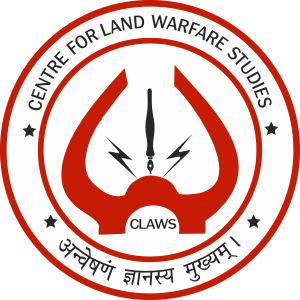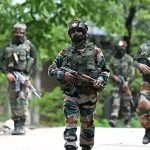The news came as a whimper, created a little ripple and then sank quietly in the whirlpool of geopolitical storm and is currently visiting the world stage —Tariffs, Alaska, Ukraine, SCO, RIC—the news was worthy of analysis.
The reference is to the announcement made by Pakistan’s PM Shehbaz Sharif ,during the country’s 79th Independence Day speech on 14 August 2025, and stated s that, the Pakistan Army will create a new command called the Army Rocket Force Command (ARFC) in order to enhance the combat capability of the Army.
This brief work analyses various aspects related to ARFC and the events that led to its creation.
A Failed Bluff
One of the main catalyser that drove the thought that ARFC was a failed bluff is a s written below:
For decades, Pakistan has been holding the bluff of nuclear blackmail against India to spread the believe that, when things go beyond a certain level, the response will be nuclear.
- This ‘make-believe’ notion tried to convey that there was minimal space for conventional conflict (that obviously would go in India’s favour based on huge comparative superiority).
- To lace the belief with some conviction, the use of ‘prohibited’ was pegged to the four thresholds—.Military penetration on a large scale which Pakistan Army is unable to stop; Complete knockdown or a comprehensive military defeat; Economic strangulation/blockade; Total political destabilisation.
- It is obvious that each of the above is the likely outcome of war with a conventionally superior adversary. The message was therefore simple — conventional military superiority won’t go far; it will hit a nuclear wall.
- To add to the ‘make believe’ Pakistan, in June 2024, announced that it has developed Tactical Nuclear Weapons (TNWs). What was the strategic message? It was that we have ‘useable’ nuclear weapons that can and will be put to use— the moment conventional military superiority of India crosses a limit.
- This was the message that the ‘undoable’ can be and will be done much short of the total collapse; a message at lowering the threshold, and by implication, further dwarfing the space for the conventional conflict.
This bluff kind of ‘held’ all along, although the conventional wisdom on our side always believed that there was plenty of space for conventional conflict between the two arch rivals.
In days that passed between the Pahalgam attack and Op Sindoor, one only had to listen to the hierarchy of Pakistani leadership to see through their ill-conceived bluff being expressed in poor oratory!… “We have nuclear weapons and we will not hesitate to use it” —PM Shebaz Sharif; “Either we live or no one will”— Pakistani Defence Minister Khawaza Asif; “We are a nuclear nation, if we think we are going down, we will take half the world down with us” —Asim Munir (this one after Op Sindoor).
Op Sindoor happened; a full four day of conflict. While it did not pan out in all its conventional dimensions, it did involve a lot of fireworks.;nine terror camps struck deep inside Pakistan and Pakistan occupied Kashmir on 07 May 2025.
This was followed by drone and counter drone duels all across the Indo-Pak border followed by precision strikes on 11 Pakistani air bases at Sargodha, Rahim Yar Khan, Nur Khan (Chaklala), Jacobabad, Bholari Sukkur, Chunian, Rafiqui, Murid, Skaru and Pasrur.
The retaliation from Pakistan came in the form of air strikes by J 8s, J 10C and others using Chinese missiles like the PL 15, firing of rockets like Fatah 1 and Fatah II and the use of offensive drone power (Bayraktar TB2, Bayraktar Akinci, Shahpar I, Anka, YH11, Burraq and more). [i]
What are the reflections?
- While the level of conflict reached nowhere near the stated thresholds, the bluff of nuclear rhetoric by the reckless Pakistani leadership was called.
- While the conventional conflict did not see large scale ground operations, it did see some serious fire power exchanges (cruise missiles Brahmos and SCALP EG, mainframe air defence weapons—S400, Akash, counter UAS weapons on our side taking on the avalanche of drone attacks along coupled with cruise missiles and rocket artillery of the adversary).
- Battle in the conventional sphere raged on, with all the stuff on the nuclear rhetoric in the ‘cold bag’ .
- Most importantly, PM Modi, while giving a call to ‘pause’ Op Sindoor, made a significant announcement— “India won’t bend to Pakistan’s nuclear blackmail”.
What were the takeaways for Pakistan herein?
- The days of pushing the ‘make-believe’ stories of ‘no space for conventional operations’ are over.
- Many of the missile arsenal (the HATF series of Surface-to-SurfaceMissiles or SSMs), that operated purely under the Nuclear Command Authority (NCA), will now have to operate in the conventional battle-space as well.
- It was time to put into place the conventional retaliation machine for real time response.
Sub-Optimality in Op Sindoor
During Op Sindoor, Pakistan operated several vectors. Apart from aircrafts delivering strikes using the standoff weapons and rockets/missiles on board, the attack/retaliation punch was mainly delivered using a hierarchy of drones, rocket artillery and cruise missiles. These were standalone vectors that operated in their own battle space. Here is how:
- The drone activity was controlled by various drone control centres ( or drone warfare command centres) located at various air bases. For instance, the Murid air base in Chakwal district of Pakistan was a major centre for the conduct of operations by Unmanned Aerial Vehicles (UAVs), Unmanned Combat Aerial Vehicles (UCAVs) and small drones. Another base from where drones were operated in big numbers is the Rahim Yar Khan air base near border with Rajasthan. Similarly Nur Khan air base was the nerve centre for the Pakistan Air Mobility Command housing its Airborne Early Warning systems.
- Basically the drones were operated from various drone centres under the air force domain.
- The response from its rocket artillery (under the Pakistan Army) like Fatah 1 ( range 140 km), Fataf II ( range 290-400km) , unguided rockets A 100 E ( range 100 km) and KRL 122 ( range 40 km) followed the Army command hierarchy.
- Since the drones and the rocket force operated in two different verticals while having the same target space, therefore, the coordination fell short of being perfect.
- Another contradiction lay in the surface-to- surface missile (SSM) force.
- Pakistan has an extensive range of multi-layered SSMs. The lowest of these rungs include the Tactical Ballistic Missiles (TBMs) viz. HATF IX- Nasr (range 70 km) capable of carrying nuclear warheads upto 0.5-5KT, HATF II Abdali ( range 180-320 km) and HATF III Ghaznavi ( range 290-320 km).
- The Medium range missiles includes the Ghauri HATF V (range 1500-1800 km) and SHAHEEN HATF VI series (range 1/ IA- 750-900 km, II- 2000-2500 km, III- 2750 km).
- The land attack cruise missiles include BABAR HATF VII ( range 500-700 km), and RAAD HATF VIII ( range 350-500km).
- Basically, the above vertical of SSMs formed the ground component of the nuclear TRIAD operating under the Nuclear Command Authority. The question now was to use them under the conventional domain. Under with hierarchy? Certainly not the NCA.
- Another issue was related to intelligence sharing. The diverse surveillance resources comprising early warning radars of Army Air Defence units and the Air Force, as well as the airborne early warning and control system (AEWCS) of Air Force had to share intelligence inputs with diverse recipients — drone control centres , artillery units holding rocket force and missile force, NCA, if need arose?
- With different weapon systems operating out of different verticals and command chains, the execution of escalation ladder cannot be smooth. At best, it will be ad hoc.
- Same was visible during the conduct of Op Sindoor wherein drones, rocket artillery, missiles and aircrafts all played up as in a potpourri response.
Army Rocket Force Command (ARFC)_
Keeping in mind for the above sub- optimality, the idea of ARFC is likely to have been conceived. It is so formatted to address the specific points as mentioned above. Here are the details:
- ARFC is to be a unified multi-domain command that will integrate the Rocket and Missile (conventional) forces under a single command and control hierarchy.
- It’s responsibility will include the complete spectrum of functions to include planning, procurement, sustenance, modernisation of the rocket and missile force including providing them fund support and setting operational priorities for their employment.
- ARFC draws its inspiration from the People’s Liberation Army’s Rocket Force (PLARF) wherein a unified command encompassing missiles and rocket forces ensures consolidation and focused modernisation leading to optimal efficiency and greater survivability.
- Putting all the missile and rocket forces under one command will likely optimize many other battle functions such as, doctrinal development, joint training and better operational and logistic control.
- One identifiable institutional structure in control of conventional response by the missile and rocket force will also lead to better intelligence sharing from sensors deployed in multiple domains of land, sea and air.
- With all surveillance and intelligence inputs flowing directly to the decision makers in command of rockets and missiles, will not only shorten the decision loop, but also, will lead to the execution of escalation response in a more optimal and a focused manner.
- It can thus be seen that, ARFC born out of the shortcomings noticed during Op Sindoor, will end up providing multiple takeaways
We are a step ahead in the ARFC idea. India’s Strategic Force Command already integrates all the strategic vectors under one command with a well defined command and control structure for a coordinated response.
At the tactical level, our conventional response by missiles and rockets is also fully integrated in the command and control structures in the Tactical Battle Area (TBA). That said, the integration of a joint air defence response needs to be fully integrated across the Army and Air force networks by seamlessly integrating the Air Defence Control and Reporting Chain configured across the Integrated Air Command and Control System ( IACCS) of the Air Force with Akashteer system of the Army.













